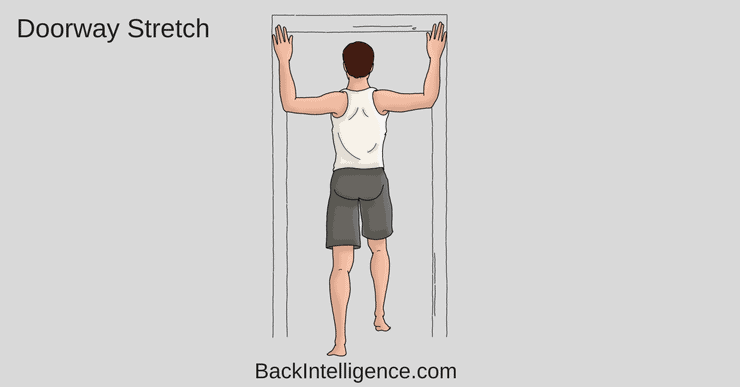
This article is going to outline how to fix rounded shoulders with a few basic exercises and some simple workstation modifications.
To begin, let’s get into a little bit of detail on what rounded shoulders are and what causes them.
What Is Rounded Shoulders Posture?
“Rounded shoulders” is a term that is used to describe the appearance of shoulders that are positioned further forward than normal. People that have rounded shoulders typically also have a Forward Head Position and increased slouching of the upper back referred to as Thoracic Kyphosis or Dowager’s Hump. [1][2][3]
This causes enormous stress on the neck and shoulders, which can lead to reduced shoulder range of motion as well as neck pain, shoulder pain, shoulder blade pain, headaches, sleep disorders, numbness, and/or loss of function, typically of the upper body region.[1][3]
Common Causes Of Rounded Shoulders:
-
- Sitting for extended periods of time in front of the computer.[1][2]
- Read or Text on the cell phone (with head down).[1]
- Driving for extended periods of time in bad posture.
- Excessive overhead activities[3]
- Sleeping with poor posture.
- Excessive weight training (particularly of the chest).
- Shoulder dysfunctions or injuries.[3]
- Breastfeeding.
- Cycling in poor posture.
- Carrying heavy backpacks.[3]
There is usually an imbalance between the muscles that should be pulling the shoulders forward and the ones that should be pulling them backwards, to maintain a neutral posture.[4]
Let’s look at the specific muscles involved….
Muscle Imbalance Causes Rounded Shoulders
– Pectoralis major and minor (Chest muscles)
– Latissimus dorsi (Low and mid back)
– Sternocleidomastoid
– Upper trapezius (Neck and upper back)
– Levator scapulae (Runs from shoulder blade to neck)
– Lower and mid trapezius (mid back)
– Serratus anterior (Side of ribs)
– Rhomboids (Back muscles)
– Rotator Cuff (Muscles around shoulder blade)
Now let’s look at how to fix rounded shoulders with exercises….
5 Best Exercises For Rounded Shoulders
This study showed that specific postural exercises can help improve this posture.[5]
We encourage you to perform the following 5 exercises 3 to 5 times a week for optimal results. You don’t need a lot of equipment – just invest in an exercise band (such as a Theraband®) and a foam roller and you’re ready to go.
1. Doorway Stretch
Because the abs and chest get super tight during sitting, the doorway stretch will help loosen it up.
How to do it:
– Position your elbows and hands in line with a doorframe.
– Step through the door slowly, until you feel a stretch.
– Hold this end position for 15 to 20 seconds before returning to the starting position.
– Repeat this stretch 3 times.
2. Trigger point release for chest muscles
This will release tight pectoralis major and minor (chest muscles) that are usually very tight in rounded shoulder posture.
How to do it:
– Grab the hook of the Theracane and position the knob in the grove just below your collarbone.
– Apply downward pressure on hook to help release the trigger point.
– Once you find a tight spot hold it there for at least 30 seconds.
– Move the hook to apply the pressure at different angles to work the whole muscle.
– Perform on both sides.
The Complete Posture Fix (With Dr. Oliver)
Fix your Rounded shoulders & Fwd Head posture, get out of pain and increase your mobility.
Learn More
3. Wall Slides
This exercise strengthens the low trapezius muscles and serratus anterior as well as opens up the shoulders and chest.
- Stand with your back to the wall and try to keep your upper back and buttocks in contact with the wall and walk your feet out about 12 inches from the wall.
- Draw-in your belly toward the wall, as to avoid an excessive arch in the low back.
- Bend your elbows to 90 degrees so that your hands are pointing up, and try to press your forearms against the wall (this may be an uncomfortable position when you first start performing this exercise)
- Slowly slide your arms up the wall and then back down the wall.
- Begin with 1 set of 10 repetitions and work your way up to 3 sets of 10 repetitions.
4. Band Pull Aparts
This exercise strengthens all of the major muscles of your back, including the Mid Trapezius and the Rhomboids which will help bring the shoulders back.
How to Do It:
- Begin standing with a good posture
- Holding a resistance band (level of resistance you use depends on your individual strength level) with both hands, straighten your elbows and bring your arms out in front of you.
- While keeping your elbows locked, slowly move your arms out and back behind your body. You should feel the muscles between your shoulder blades contracting/squeezing.
- Only go out as far as comfortable. Some muscular discomfort (burning) is ok, but pain in the arms or neck is not.
- Avoid shrugging your shoulders toward your ears.
- Repeat 2×10, gradually increasing to 3×10.
- By the time you get to repetition number 8, 9, 10, this should be challenging. If it is not, increase the level of resistance on the band.
5. Thoracic Spine Foam Rolling
This is great way to loosen up the upper back area.
- Lie on your back, with your hands placed behind your head, and a foam roller placed under your upper-back.
- Start to slowly roll up and down beginning at your mid-back and moving towards the top of your shoulders.
- Keep your core tight and use your legs to roll.
- Don’t rush, do nice and slow rolls.
Plus Check out these exercises from Leon:
Lastly, Your Ergonomic Workstation!
If you work a 9 to 5 office job, you’re likely spending the majority of your day sitting at your desk, which may be contributing to your rounded shoulders.
Setting up your workstation in an ergonomically friendly way is essential for improving posture and helping to correct rounded shoulders. The better your posture is while you’re at work, the easier it will be to prevent and correct rounded shoulders, so put some thought into the design of your workstation.
Tips for an ergonomically correct workstation to combat rounded shoulders:
– Ensure that your chair is positioned so that your thighs are perpendicular to your calves, with your knees bent at a 90 degree.
– Maintain a low back arch (which is natural), using a low back support cushion.
– Ensure that the top 1/3 of your computer monitor is in line with your eye level. This will help you look up, instead of down.
– Take regular breaks to walk around and stretch out your neck and upper back.
In Conclusion:
If you suffer with rounded shoulders you may not like the way you look, or you may be suffering with neck and upper back pain. By performing the exercises mentioned in this article and modifying your workstation, you can now fix your rounded shoulders posture.
Learn More
Related Articles:
How can poor posture cause back pain
7 Herniated Disc Exercises
How To Ease Lower Back Pain Naturally
How To Sleep With Lower Back Pain – The Dos And Don’s
Severe Back Pain During Pregnancy? 5 Causes & 10 Remedies
Ice Or Heat For Back Pain Relief
Sources:
https://www.ncbi.nlm.nih.gov/pmc/articles/PMC4154278/
https://www.ncbi.nlm.nih.gov/pmc/articles/PMC5684019/
https://www.journalchiromed.com/article/S1556-3707(16)30161-4/abstract
https://www.omicsonline.org/open-access/kinematic-causes-and-exercise-rehabilitations-of-patients-with-round-shoulder-thoracic-kyphosis-and-forward-head-posture-fhp-2161-1165-1000263.php?aid=81049&view=mobile
Sources:
[1] Lv P, Peng Y, Zhang Y, Ding K, Chen X. Kinematic causes and exercise rehabilitations of patients with round shoulder, thoracic kyphosis and forward head posture (FHP). Epidemiology: Open Access. 2016;6(5). doi:10.4172/2161-1165.10002633
[2] Nejati P, Lotfian S, Moezy A, Nejati M. The study of correlation between forward head posture and neck pain in Iranian office workers Int J Occup Med Environ Health. 2015. doi:10.13075/ijomeh.1896.00352
[3] Singla D, Veqar Z. Association between forward head, rounded shoulders, and Increased thoracic kyphosis: A review of the literature. J Chiropr Med. 2017;16(3):220-229. doi:10.1016/j.jcm.2017.03.004
Licensed chiropractor, DC (Owner of Forme Clinic, Stoney Creek, ON, L8G 1B9)
Dr. Shaina McQuilkie graduated from Brock University in 2004 with a Bachelor of Kinesiology (Honours). She then attended D’Youville College, in Buffalo, New York and obtained her Doctorate of Chiropractic Degree in 2008. After graduating, Dr. McQuilkie practiced in a multi-disciplinary healthcare facility based in Hamilton, Ontario gaining experience treating a variety of musculoskeletal injuries.








